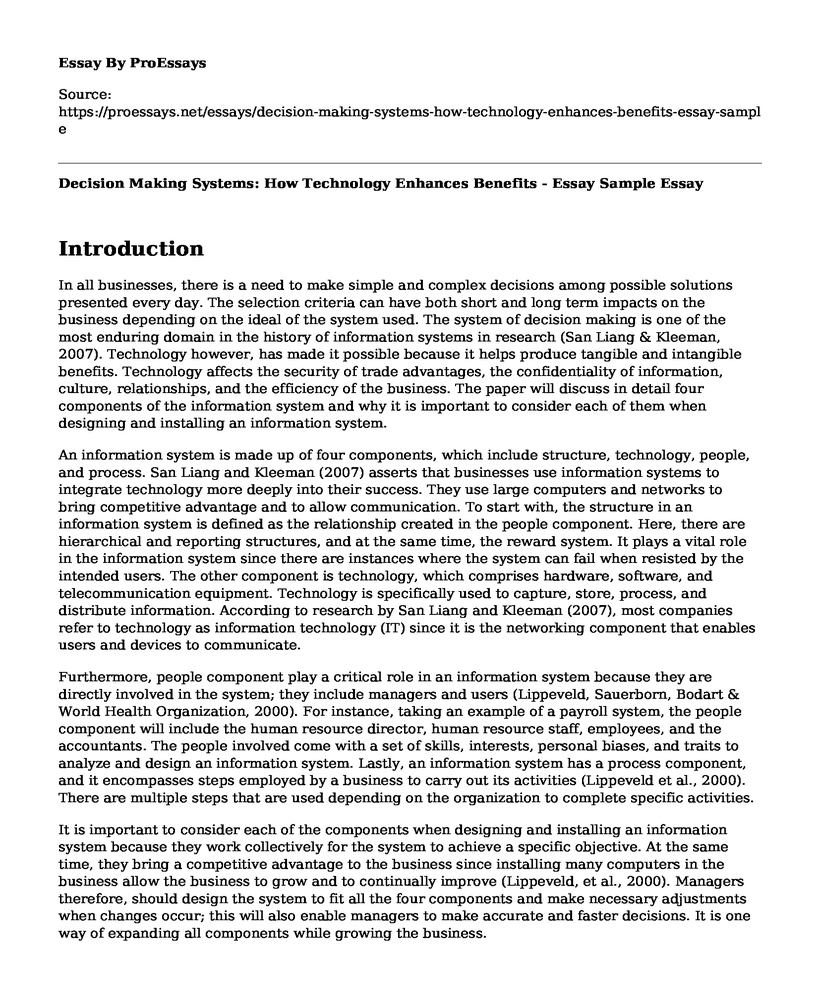Introduction
In all businesses, there is a need to make simple and complex decisions among possible solutions presented every day. The selection criteria can have both short and long term impacts on the business depending on the ideal of the system used. The system of decision making is one of the most enduring domain in the history of information systems in research (San Liang & Kleeman, 2007). Technology however, has made it possible because it helps produce tangible and intangible benefits. Technology affects the security of trade advantages, the confidentiality of information, culture, relationships, and the efficiency of the business. The paper will discuss in detail four components of the information system and why it is important to consider each of them when designing and installing an information system.
An information system is made up of four components, which include structure, technology, people, and process. San Liang and Kleeman (2007) asserts that businesses use information systems to integrate technology more deeply into their success. They use large computers and networks to bring competitive advantage and to allow communication. To start with, the structure in an information system is defined as the relationship created in the people component. Here, there are hierarchical and reporting structures, and at the same time, the reward system. It plays a vital role in the information system since there are instances where the system can fail when resisted by the intended users. The other component is technology, which comprises hardware, software, and telecommunication equipment. Technology is specifically used to capture, store, process, and distribute information. According to research by San Liang and Kleeman (2007), most companies refer to technology as information technology (IT) since it is the networking component that enables users and devices to communicate.
Furthermore, people component play a critical role in an information system because they are directly involved in the system; they include managers and users (Lippeveld, Sauerborn, Bodart & World Health Organization, 2000). For instance, taking an example of a payroll system, the people component will include the human resource director, human resource staff, employees, and the accountants. The people involved come with a set of skills, interests, personal biases, and traits to analyze and design an information system. Lastly, an information system has a process component, and it encompasses steps employed by a business to carry out its activities (Lippeveld et al., 2000). There are multiple steps that are used depending on the organization to complete specific activities.
It is important to consider each of the components when designing and installing an information system because they work collectively for the system to achieve a specific objective. At the same time, they bring a competitive advantage to the business since installing many computers in the business allow the business to grow and to continually improve (Lippeveld, et al., 2000). Managers therefore, should design the system to fit all the four components and make necessary adjustments when changes occur; this will also enable managers to make accurate and faster decisions. It is one way of expanding all components while growing the business.
Conclusion
In conclusion, structure, technology, people, and process components of an information system are interdependent. Changes with one component will affect the other and thus an impact on the business. The main reason for a business to have an information system is to enhance its efficiency and effectiveness. Technology strengths the existence of information systems hence making businesses to stand out. Like electricity, information system helps to reduce costs, ensure that the business is running, and minimize risks.
References
Carton, F., & Adam, F. (2010). Understanding the Impact of Technology on Managerial Decision Making-The The Case of the ERP System. In DSS (pp. 407-418). Retrieved from: https://www.researchgate.net/profile/Fergal_Carton/publication/220762826_Understanding_the_Impact_of_Technology_on_Managerial_Decision_Making_-_The_Case_of_the_ERP_System/links/00b7d520a4c583b51e000000.pdf
Lippeveld, T., Sauerborn, R., Bodart, C., & World Health Organization. (2000). Design and implementation of health information systems. Retrieved from: https://apps.who.int/iris/bitstream/handle/10665/42289/9241561998.pdf
San Liang, X., & Kleeman, R. (2007). A rigorous formalism of information transfer between dynamical system components. II. Continuous flow. Physica D: Nonlinear Phenomena, 227(2), 173-182. Retrieved from: http://eaton.math.rpi.edu/CSUMS/Papers/InfoFlow/kleemaninfotransfer.pdf
Cite this page
Decision Making Systems: How Technology Enhances Benefits - Essay Sample. (2023, Mar 24). Retrieved from https://proessays.net/essays/decision-making-systems-how-technology-enhances-benefits-essay-sample
If you are the original author of this essay and no longer wish to have it published on the ProEssays website, please click below to request its removal:
- Business Essay Example: Restaurant Business Description
- Essay Sample on Democratic, Participative Leadership Style
- Essay Example on Organizational Developments: Updating Outdated IT & Telephone Networks
- International Expansion: Navigating the Competitive Global Marketplace - Research Paper
- Paper Example on MECK Insurance's Cultural Transformation: Setting Direction and Aligning Leadership
- Essay Example on Successful Implementation of ERP System in SMEs in Iraq: Key Factors
- Essay Sample on Leadership: Ethics and Courage, Key Values for Success







